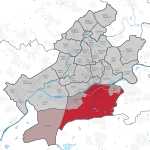Deutschordenskirche (Frankfurt am Main)
Buildings and structures of the Teutonic OrderChurches in the Diocese of LimburgFrankfurt-AltstadtRoman Catholic churches in Frankfurt
The Deutschordenskirche (often shortened to Deutschorden) in Frankfurt am Main is a Roman-Catholic church in the district of Sachsenhausen. Unlike most historical churches in Frankfurt's city-center which are owned by the city of Frankfurt, Deutschorden is property of the Teutonic Order which maintains it as part of its convent at Frankfurt. Next to the Deutschordenskirche is the Deutschordenshaus, an attached former convent-building.
Excerpt from the Wikipedia article Deutschordenskirche (Frankfurt am Main) (License: CC BY-SA 3.0, Authors).Deutschordenskirche (Frankfurt am Main)
Brückenstraße, Frankfurt Sachsenhausen (Süd)
Geographical coordinates (GPS) Address Nearby Places Show on map
Geographical coordinates (GPS)
| Latitude | Longitude |
|---|---|
| N 50.106388888889 ° | E 8.6883333333333 ° |
Address
Brückenstraße 7
60594 Frankfurt, Sachsenhausen (Süd)
Hesse, Germany
Open on Google Maps










